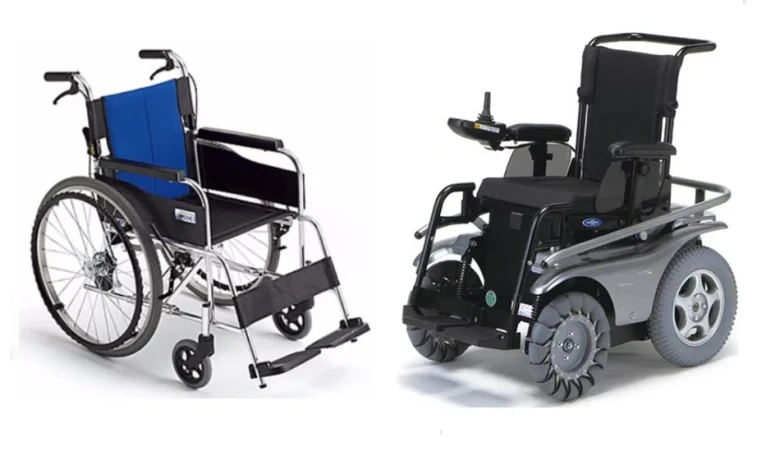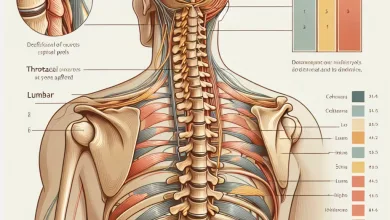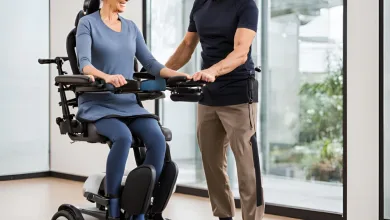Electric Wheelchairs vs. Manual Wheelchairs: A Complete Guide

Table of Contents
Electric Wheelchairs vs. Manual Wheelchairs: A Complete Guide
Finding Freedom: Electric vs. Manual Wheelchairs
Imagine gliding effortlessly through the park, conquering errands with ease, or simply navigating your home with renewed confidence. Wheelchairs, both electric and manual, empower individuals to maintain an active and independent lifestyle. But with so many options, choosing the right one can feel overwhelming. This guide of Electric Wheelchairs Vs. Manual Wheelchairs will unveil the key differences between electric and manual wheelchairs, helping you find the perfect fit for your needs.
Understanding Your Needs: The Key to Choosing Wisely
Before diving into specifics, it’s crucial to consider your unique needs and preferences. Here are some essential factors to ponder:
- Upper Body Strength and Endurance: Manual wheelchairs require ongoing self-propulsion, so upper body strength is vital. Electric wheelchairs, on the other hand, minimize physical exertion.
- Daily Activities and Independence: Consider your daily routine. Do you need to cover long distances or navigate tight spaces frequently? Electric wheelchairs offer a greater range and may be ideal for extensive outings.
- Environment: Will you primarily use the wheelchair indoors or outdoors? Maneuverability in tight spaces is a key consideration.
- Budget: Electric wheelchairs typically come with a higher price tag compared to manual wheelchairs.
Now, let’s delve deeper into the world of electric and manual wheelchairs!
Electric Wheelchairs: Powering Up Your Independence
Benefits of a Power Chair:
Electric wheelchairs, also known as power chairs, are battery-powered and controlled using a joystick. They offer a plethora of advantages:
- Reduced Physical Exertion: Electric wheelchairs minimize the need for self-propelling, making them ideal for individuals with limited upper body strength or those who tire easily.
- Increased Independence and Range: Electric wheelchairs easily conquer longer distances and inclines, allowing you to explore further and participate in more activities.
- Enhanced Comfort: Electric wheelchairs often provide comfortable seating options, adjustable features, and a smoother ride, especially on uneven terrain.
- Advanced Features: Some electric wheelchairs boast impressive technology like obstacle avoidance sensors or customized seating adjustments.
Considering the Other Side of the Coin:
While electric wheelchairs provide undeniable benefits, some factors need consideration:
- Cost: Electric wheelchairs generally have a higher upfront cost than manual wheelchairs.
- Bulk and Weight: Electric wheelchairs tend to be heavier and bulkier, making them less portable and potentially challenging to transport.
- Battery Reliance: Electric wheelchairs depend on battery power, so keeping them charged is crucial.
- Maneuverability: While some electric wheelchairs can navigate tight spaces, others might have a wider turning radius.
Electric Wheelchairs:
- Folding Electric Wheelchairs: These models offer portability and easy storage.
- Heavy-Duty Models: Designed for robust use and higher weight capacities.
- Travel-Friendly Options: Lightweight and compact, perfect for frequent travellers.
Manual Wheelchairs:
- Rigid Frame: Known for durability and performance.
- Folding Frame: Easier to transport and store.
- Sports Wheelchairs: Designed for athletic activities.
- Lightweight Models: Easier to maneuver and transport.
Is a Mobility Scooter Better Than an Electric Wheelchair?
Mobility scooters and electric wheelchairs serve similar purposes but are designed for different needs. Mobility scooters are generally used for outdoor travel and longer distances. At the same time, electric wheelchairs are more versatile and can be used indoors and outdoors. If you need a mobility aid for extensive outdoor use, a mobility scooter might be a better option. However, for indoor use and navigating tight spaces, an electric wheelchair is more practical.
Power Wheelchair vs. Mobility Scooters
When comparing a power wheelchair vs. mobility scooters, it’s important to consider the intended use. Power wheelchairs are better for individuals who need continuous support and assistance with daily activities. Mobility scooters, on the other hand, are ideal for occasional use and longer outdoor trips. Power wheelchairs offer more stability and maneuverability in confined spaces, whereas mobility scooters are designed for open areas and rough terrains.
Here’s a quick comparison:
| Feature | Electric Wheelchair | Mobility Scooter |
| Maneuverability | More Maneuverable | Less Maneuverable |
| Focus | Daily Use | Short Trips, Stability |
| User Control | Joystick | Tiller/Handlebars |
How to Use a Power Chair vs. a Mobility Scooter
Both electric wheelchairs and mobility scooters offer motorized assistance, but using them differs slightly.
Electric Wheelchair:
- Joystick Control: Electric wheelchairs are steered using a joystick mounted on the armrest. This allows for one-handed control, which is ideal for those with limited upper-body mobility.
- Practice Makes Perfect: Like any new skill, practice maneuvering your electric wheelchair in a safe, controlled environment is crucial. Mastering turns, starts, and stops will boost your confidence and ensure smooth navigation.
- Seat Adjustments: Many electric wheelchairs offer adjustable seating options for optimal comfort and support. Take time to find the perfect configuration for your needs.
Mobility Scooter:
- Tiller/Handlebar Control: Mobility scooters are steered using a tiller or handlebars, similar to a bicycle. This typically requires both hands for operation.
- Getting Comfortable: Familiarize yourself with the scooter’s controls before venturing out. Practice maneuvering in a safe space to feel confident behind the wheel.
- Mind the Speed: While some mobility scooters can reach higher speeds than electric wheelchairs, prioritize safety and maintain a moderate pace, especially in crowded areas.
Technological Advancements in Wheelchairs
The world of wheelchairs is no stranger to innovation. Gone are the days of purely mechanical devices. Modern wheelchairs are embracing technology, transforming them into powerful tools for mobility and independence. Let’s explore some exciting advancements:
- Smart Features: Wheelchairs are becoming more intelligent than ever! Imagine controlling your chair using voice commands, navigating with built-in GPS, or accessing wheelchair-accessible apps directly from the control panel. These features enhance user experience and independence in remarkable ways.
- Connectivity: The future of wheelchairs is connected. Some electric wheelchairs can now connect to smartphones, allowing for advanced control options and personalized settings. Imagine adjusting speed, customizing lighting, or monitoring battery life – all from your phone! This level of connectivity empowers users to manage their mobility with greater ease and control.
Benefits of a Power Chair
Power chairs offer numerous benefits, including enhanced mobility, increased independence, and advanced comfort features. They are designed to provide a smooth and effortless ride, making them ideal for individuals with severe mobility impairments. The ability to adjust the seat, tilt, and recline adds to the comfort and support, making power chairs a preferred choice for long-term use.
Making the Perfect Choice: It’s All About You!
Now that you’ve explored the strengths and considerations of electric and manual wheelchairs, it’s time to make an informed decision. Remember, the “perfect” wheelchair depends entirely on your unique needs and lifestyle.
Here are some key takeaways to ponder:
- Consider your physical capabilities and limitations.
- Think about your daily activities and desired level of independence.
- Evaluate your environment, both indoors and outdoors.
- Don’t hesitate to consult a healthcare professional or occupational therapist for personalized guidance.
- Test drive different models! Trying out various wheelchairs firsthand is invaluable for finding the most comfortable and maneuverable for you.
Maintaining Your Manual vs. Power Wheelchair: A Quick Comparison
Both manual and power wheelchairs require regular maintenance to ensure smooth operation and safety. Here’s a quick comparison of the key maintenance tasks for each type:
Manual Wheelchairs:
- Cleaning: Regularly clean the frame and upholstery.
- Tire Maintenance: Check tire pressure and tread.
- Lubrication: Lubricate moving parts to ensure smooth operation.
- Brake Inspection: Regularly check and adjust brakes.
Power Wheelchairs:
- Battery Care: Keep the battery charged and replace it when necessary.
- Motor Maintenance: Regularly inspect and maintain the motor.
- Error Codes: Pay attention to any error codes or issues that arise.
- Scheduled Checkups: Regular checkups by a professional are highly recommended.
Understanding these maintenance differences ensures your wheelchair remains in top condition, granting you continued mobility and independence.
Frequently Asked Questions (FAQs)
Q: How much does an electric wheelchair cost?
A: The cost of an electric wheelchair can vary depending on features, brand, and customization options. Prices typically range from a few thousand dollars to upwards of ten thousand dollars.
Q: Does insurance cover electric wheelchairs?
A: In some cases, insurance may cover the cost of an electric wheelchair, especially if deemed medically necessary. It’s best to consult your insurance provider for specific coverage details.
Q: How do I maintain my electric wheelchair?
A: Regular maintenance ensures your electric wheelchair functions safely and efficiently. Refer to the manufacturer’s instructions for specific cleaning and maintenance procedures. Generally, this includes keeping the battery charged, checking tire pressure, and inspecting for any loose parts.
Q: Can I travel with an electric wheelchair?
A: Yes, you can travel with an electric wheelchair! Airlines typically require notification in advance and may have specific procedures for transporting wheelchairs. Always check with your airline for their particular guidelines.
Q: Where can I find more information about electric wheelchairs?
A: Numerous resources are available online and through healthcare professionals. Here are a few reputable organizations to explore:
- The National Institute on Disability, Independent Living, and Rehabilitation Research (NIDILRR): http://acl.gov/about-acl/about-national-institute-disability-independent-living-and-rehabilitation-research
- The American Occupational Therapy Association (AOTA): https://www.aota.org/
- The Christopher & Dana Reeve Foundation: https://www.christopherreeve.org/
Q: Can I customize my wheelchair?
A: Yes, many manufacturers offer customization options to suit your specific needs, including seating, controls, and accessories.
Q: How do I choose a suitable wheelchair for my child? A: Pediatric wheelchairs are designed specifically for children. Consult a healthcare professional to find the best fit for your child’s needs.
Closing Note: Your Journey to Mobility and Independence Starts Here!
We’ve explored the world of electric and manual wheelchairs, delving into their strengths, considerations, and even some exciting technological advancements. Choosing a suitable wheelchair is a crucial decision, and we hope this guide has equipped you with the knowledge to make an informed choice that perfectly suits your needs and lifestyle.
Remember, the perfect wheelchair empowers you to explore the world with confidence and independence. Whether you’re seeking a reliable manual chair or a feature-rich electric model, there’s a perfect option waiting for you.
We’d love to hear from you! Do you have any questions about wheelchairs or your personal mobility journey? Share your thoughts and experiences in the comments section below. Let’s create a supportive community where everyone can explore the possibilities of a mobile and independent life!



